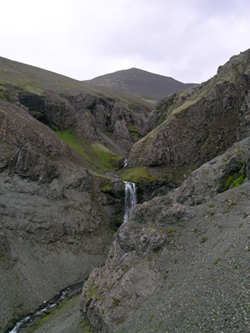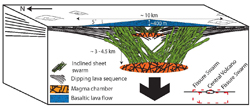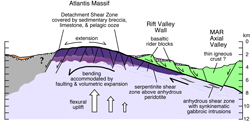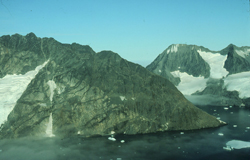Scope of Investigation
Structural and tectonic studies of rift and transform lithosphere plate boundaries reveal major processes of accretion and deformation of oceanic lithosphere and ocean/continent transitions. Investigations on both the seafloor and the continents provide data and ideas relevant to processes from the initial rupture of continental lithosphere to seafloor spreading. In the East African Rift System, detailed structural studies define the geometry and kinematics of active rifting and document the birth of a rifted continental margin. Investigations of the ocean-continent transition and coastal dike swarms of the Tertiary East Greenland volcanic rifted margin reveal the transition from continental rifting to seafloor spreading. The Mid-Atlantic Ridge and East Pacific Rise spreading centers and transform faults are examined from the perspective of the submersible Alvin and various other seafloor mapping tools. By importing land-based geological and geophysical techniques to the seafloor, our group investigates the geology of the oceanic crust and the processes that affect it. Studies of ophiolite complexes, ancient oceanic lithosphere exposed in mountain belts, reveal the deep structure of crust and upper mantle produced by seafloor spreading. Subaerial spreading in Iceland provides an additional perspective on crustal accretion and faulting. Integrating these diverse studies has proven to be useful in developing and refining models of crustal deformation in extensional and strike-slip tectonic regimes. Focused investigations on fault zones, hydrothermal systems, and basaltic lava flows provide important constraints on crustal accretion in oceanic regimes.


Processes at Divergent Plate Boundaries
About a quarter century ago the emergence of Plate Tectonics provided a new framework within which to consider the major processes that have shaped the Earth. In general, this paradigm defined the Earth in terms of rigid lithosphere plates and narrow, intervening plate boundaries where the plates interact with one another and with the much weaker, underlying asthenosphere. All of the “action” on our planet (and many other planetary bodies that behave similarly) is at or near the plate boundaries. These boundaries are narrow compared to the widths of the plates, but vary from a few kilometers to a few hundred kilometers in width. There are three end-member types of plate boundaries as well as hybrid forms: convergent, divergent, and translational. Our research group has its greatest strength and experience in processes at divergent and translational boundaries. These include mid-ocean ridge spreading centers and transform faults as well as continental rifts and related strike-slip faults.


Our group’s research includes active investigations on some of the preeminent examples, or “type localities”, of these plate boundary zones. These include both active plate boundaries that are linked to the present plate mosaic, such as the Mid-Atlantic Ridge, East Pacific Rise, East African Rift, and Iceland. Other important studies on fossil examples of plate boundaries exposed in classic geologic terranes, such as the Great Dyke, Skaergaard, and other mafic intrusions exposed in deeply eroded rift structures; and on-land exposures of ancient oceanic crust produced at spreading centers and transforms called “ophiolites”. These studies effectively cover all of the major divergent and translational plate tectonic environments on Earth. The combination of studies of ancient and active rifts and transforms, together with studies of their surficial and subsurface expressions yield a three-dimensional perspective on these major Earth processes.
Significance to Global Processes
One might ask: Is this research area significant in terms of scientific and social imperatives? Here are a few possible responses. Processes at mid-ocean ridges have produced about 60% of the crustal area of the Earth. For probably the last 4 Billion years, these environments have marked the sites of the main flux of mass and energy transfer from the Earth’s interior to the surface. They are the sites of hydrothermal vent systems that actively produce exhalative sulfide mineral deposits, support chemosythetic biological communities, and profoundly affect the chemistry of seawater. Continental rifts widen and evolve into continental margins, the thickest sediment accumulations on Earth and the repository of substantial petroleum reserves. The bulk of sedimentary rocks that are exposed in mountain belts were originally deposited in rift or continental margin settings. The sedimentary fill and crustal underpinnings of rifts themselves are potential sources of petroleum as well as mineral deposits. In addition, they contain lacustrine sediments that record several million years of climatic variations, similar to that seen in tree growth rings on a shorter time interval. These points emphasize how fundamental processes in rifts are to many other aspects of Earth Sciences.
Transform faulting is a ubiquitous element of all divergent plate boundaries ranging from major strike-slip faults to relatively minor transfer structures. Some of the most damaging earthquakes in history and numerous regions of persistent seismicity are the direct result of transform faulting in continental areas. The detailed study of the behavior and mechanical implications of crustal stress, strain, and seismicity along the San Andreas Fault in particular has forced a re-evaluation of the behavior of the potentially dangerous major faults that dominate plate boundaries zones. Investigations of basaltic fault rocks promise to provide new insights into the most common fault materials on Earth.
Investigating these front-line scientific problems cannot be done with any individual technique; a multidisciplinary approach is necessary because of the non-uniqueness of interpretations that stem from nearly all types of geological and geophysical information when viewed in isolation. Moreover, major processes in rift and transform environments are governed by a complex interplay between multiple parameters. For example, faults create permeable pathways in the Earth that permit fluid flow. The fluids exert both chemical and mechanical influences on the strength of rocks, thus may determine the nature of faulting and earthquakes. Our department has personnel that cover the key subdisciplines required to make major contributions to the understanding of the processes that interact at divergent and transform plate boundaries.


